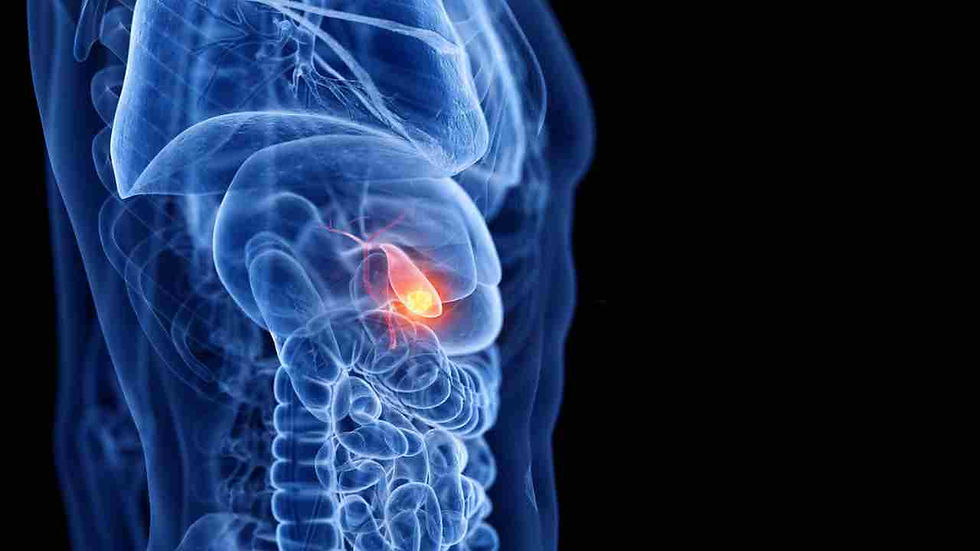Can Motesanib (AMG 706) help in gallbladder cancer treatment?
- abhishek6945
- Sep 15, 2023
- 4 min read
Updated: Apr 1, 2024
The condition that occurs due to the proliferation of cells that are present in the lining of the gallbladder (a small organ underneath the liver) is known as gallbladder cancer (GBC). Initially, there may not be any symptoms in this condition. But as the disease progresses to an advanced stage, symptoms such as abdominal pain, jaundice, fever, and bloating sensation might appear..
What are the existing therapies for GBC?
Gallbladder cancer treatment comprises of:
Surgery: Cholecystectomy (removal of the gallbladder), radical gallbladder resection (removal of the gallbladder along with a portion of the involved liver) and palliative surgery are the surgical options used in gallbladder cancer.
Endoscopic mucosal resection and laparoscopic surgery: They are minimally invasive procedures that are done by passing the endoscope through the lumen of the stomach into the gallbladder and by removing the tumor.
Radiotherapy: Before or after surgery, radiation therapy can be used to reduce the size of the tumor and eradicate any cancer cells that may still be present. The common types of radiation therapy used in gallbladder cancer are external radiation therapy and internal radiation therapy.
Chemotherapy: After surgery, chemotherapy should be administered to prevent the recurrence of GBC. The most common chemotherapeutic drug prescribed for six months following surgery in GBC is capecitabine. gemcitabine, fluorouracil (5-FU), cisplatin,oxaliplatin, and nab-paclitaxel are the other medications that are frequently used to treat gallbladder cancer. Chemotherapeutic side effects can range from fatigue to risk of infection, nausea and vomiting, hair loss, loss of appetite, diarrhea, neuropathy and edema, depending on the patient’s general health status and the dose administered.
Chemoradiotherapy: Chemo radiotherapy is a treatment option that combines radiation therapy and chemotherapy. After the completion of surgery and chemotherapy, chemoradiotherapy may occasionally be used to eradicate any leftover cancer cells[1].
Targeted therapy and Immunotherapy: Ivosidenib and pemigatinib are examples of drugs used in targeted therapy for gallbladder cancer, whereas pembrolizumab, nivolumab, and durvalumab are examples of immunotherapy medications for this condition. They are used to treat advanced gallbladder cancer that has either recurred or cannot be surgically removed[2].
What are tyrokinase inhibitors?
Tyrosine kinases have become important targets for drug discovery due to their involvement in the development and progression of tumors.
Tyrosine kinase inhibitors (TKIs) prevent the appropriate kinases from phosphorylation, which in turn prevents the activation of signaling pathway.
The development of numerous powerful and well-tolerated TKIs with single or multiple targets, including as epidermal growth factor receptor, fibroblast growth factor receptor, platelet-derived growth factor receptor, and rearranged during transfection receptor over the past 20 years has aided in the realization of precision cancer treatment based on the unique features of each patient's genetic mutation.
TKIs have significantly altered the therapy paradigm for different solid tumors and enhanced patient survival and quality of life[3].
How does motesanib helps in treating GBC?

One such tyrokinase inhibitor receptor is Motesanib(AMG-706) which has abundant antineoplastic activity. It can be administered orally and targets vascular endothelial growth factor (VEGFR), platelet-derived growth factor (PDGFR), and rearranged during transfection receptors. These receptors are specifically inhibited by AMG 706; thus, preventing angiogenesis and cellular proliferation of the tumor.
These properties will make motesanib suitable to use for solid tumors like non-small cell lung cancer and gallbladder cancer. According to the literature, motesanib can be effectively used in treatment of recurrent or refractory or advanced gall bladder cancer which is not amenable to surgery[4].
What are the drawbacks of motesanib?
Based on the results of the clinical trials that are conducted to know the efficacy of motesanib in gallbladder cancer patients, it is documented that administration of AMG 706is associated with side effects like increased gallbladder volume, decreased ejection fraction, biliary sludge(accumulation of biliary tract with particulates), gallstone formation, and infrequent cholecystitis(inflammation of the gallbladder) [5].
Future outlook!
AMG 706 holds tremendous potential as a revolutionizing treatment for gallbladder cancer. It provides new hope in combating this devastating disease because of its capacity to prevent angiogenesis, and cellular proliferation. However, additional investigation is required to confirm its effectiveness and safety in clinical settings.
References
1. Z. I. Hu and K.-H. Lim, “Evolving Paradigms in the Systemic Treatment of Advanced Gallbladder Cancer: Updates in Year 2022,”Cancers (Basel), vol. 14, no. 5, p. 1249, Feb. 2022, doi: 10.3390/cancers14051249.
2. H. Kuipers et al., “Gallbladder Cancer: Current Insights in Genetic Alterations and Their Possible Therapeutic Implications,”Cancers (Basel), vol. 13, no. 21, p. 5257, Oct. 2021, doi: 10.3390/cancers13215257.
3. L. Huang, S. Jiang, and Y. Shi, “Tyrosine kinase inhibitors for solid tumors in the past 20 years (2001–2020),”Journal of Hematology & Oncology, vol. 13, no. 1, p. 143, Oct. 2020, doi: 10.1186/s13045-020-00977-0.
4. Jonsson Comprehensive Cancer Center, “A Phase Ib, Open-Label, Sequential, Dose-Finding, Study of AMG 706 in Combination With Gemcitabine to Treat Subjects With Solid Tumors,” clinicaltrials.gov, Clinical trial registration NCT00324597, Sep. 2013.Available: https://clinicaltrials.gov/ct2/show/NCT00324597
5. Amgen, “An Open-Label, Randomized, Phase 1b Study Evaluating the Effect of Different Doses of AMG 706 on the Gallbladder in Subjects With Advanced Solid Tumors,” clinicaltrials.gov, Clinical trial registration NCT00448786, Jan. 2011.Available: https://clinicaltrials.gov/ct2/show/NCT00448786










Comments